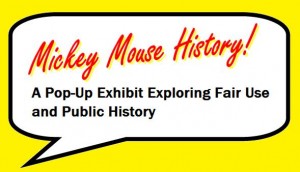“Mickey Mouse History”: A pop-up exhibit exploring fair use and public history
08 April 2015 – Julie Rogers
 Public historians rely on images, audio, and film to engage the public and interpret the past. But almost every professional has experienced confusion over copyright restrictions or faced expensive licensing agreements. Some of us may get by with using images from the public domain, but many historical images remain under copyright. What happens when you want to interpret Mickey Mouse, a comic strip, a National Geographic cover, or some other copyrighted work as a historical artifact?
Public historians rely on images, audio, and film to engage the public and interpret the past. But almost every professional has experienced confusion over copyright restrictions or faced expensive licensing agreements. Some of us may get by with using images from the public domain, but many historical images remain under copyright. What happens when you want to interpret Mickey Mouse, a comic strip, a National Geographic cover, or some other copyrighted work as a historical artifact?
There is a “culture of fear and doubt” that prevents public historians from making fair use of copyrighted works in their exhibitions, films, or other works. This pop-up exhibit at the National Council on Public History’s annual meeting in Nashville seeks to address that problem. The exhibit has two goals: to raise awareness about the right to fair use and to collect stories from public historians navigating the use of images and copyright law in their work.
In the book, Reclaiming Fair Use, intellectual property scholars Patricia Aufderheide and Peter Jaszi argue that copyright has one purpose: to promote the creation of culture. The doctrine of fair use was first defined in an 1841 Supreme Court case and codified in the Copyright Act of 1976. Fair use is both an integral part of copyright law and a legal right that encourages creativity and allows new users to add meaning and value to the original copyrighted work.
The doctrine of fair use can be defined as the right to use copyrighted material without permission or payment–under some circumstances. The important questions to determine fair use are: 1) is the use transformative? and 2) is the extent of the use appropriate? It can be difficult to answer these questions alone. Other communities have defined guidelines for fair use for visual arts, libraries, and documentary film. Because of the varied nature of our work, public historians need their own code of best practices.
We need your help! This pop-up exhibit will start a conversation about the common problems and concerns with copyright in the public history field. This anecdotal evidence will help to shape a code of best practices for public historians.
We hope everyone who works with images regularly will stop by the pop-up exhibit in Nashville to share their stories and experiences.
Here’s how you can contribute to the pop-up exhibit:
1) Think about your own experiences with copyright and fair use at your site/organization.
2) Take the survey online or plan to fill it out in-person in Nashville.
3) Illustrate your story for the pop-up exhibit. Print out an image to bring to Nashville!
- Please make sure to print the image prior to arriving at the pop-up exhibit. We will not have access to a printer on site.
4) Write a label for your image. Download a pdf of the label template.
- In 50 words or less, write a brief description of your image on the label template.
- Feel free to include a question, challenge, or vision for the future on your label to spark conversation and engage participants at the exhibit!
5) Bring your image and label to the conference in Nashville and stop by the Fair Use and Public History Pop-Up Exhibit on Friday, April 17th in the Exhibit Hall
Not attending the NCPH annual meeting? All public historians are welcome to take the survey.
~ Julie Rogers is a graduate student in the Public History program at American University. She became interested in fair use while working with comic books and pulp magazines as a Junior Fellow at the Library of Congress.



